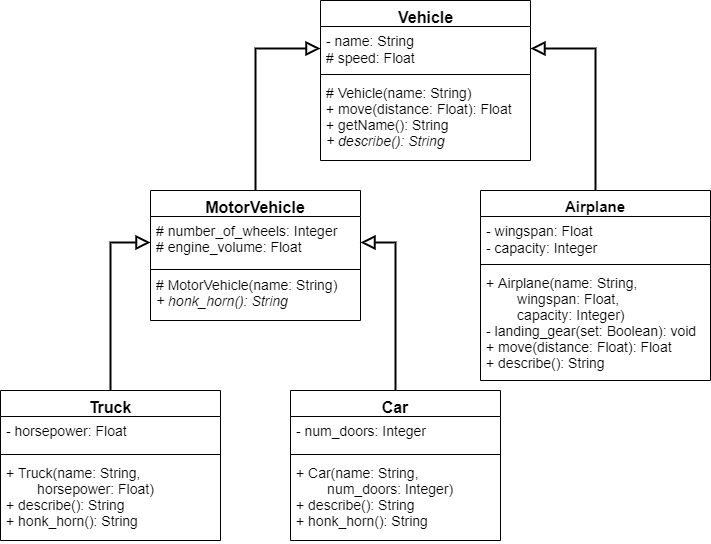Static and Abstract
The other important modifier we can use in Java is the static modifier. Again, we’ve seen this modifier each time we declare the main method in our programs, but we haven’t really been able to discuss exactly what it means. Thankfully, we now have the knowledge we need to talk about the static modifier.
In essence, the static modifier makes an attribute or method part of the class in which it is declared instead of part of objects instantiated from that class. If we think about it, the word static means “lacking in change”, and that’s sort of a good way to think about it.
Static Attributes
First, we can use the static modifier with an attribute, attaching that attribute to the class instead of the instance. Here’s an example:
public class Stat{
public static int x = 5;
public int y;
public Stat(int an_y){
this.y = an_y;
}
}In this class, we’ve created a static attribute named x, and a normal attribute named y. Here’s a main() method that will help us explore how the static keyword operates:
public class Main{
public static void main(String[] args){
Stat someStat = new Stat(7);
Stat anotherStat = new Stat(8);
System.out.println(someStat.x); // 5
System.out.println(someStat.y); // 7
System.out.println(anotherStat.x); // 5
System.out.println(anotherStat.y); // 8
someStat.x = 10;
System.out.println(someStat.x); // 10
System.out.println(someStat.y); // 7
System.out.println(anotherStat.x); // 10
System.out.println(anotherStat.y); // 8
Stat.x = 25;
System.out.println(someStat.x); // 25
System.out.println(someStat.y); // 7
System.out.println(anotherStat.x); // 25
System.out.println(anotherStat.y); // 8
}
}First, we can see that the attribute x is set to 5 as its default value, so both objects someStat and anotherStat contain that same value. Then we can update the value of x attached to someStat to 10, and we’ll see that both objects will now contain that value. That’s because the value is static, and there is only one copy of that value for all instances of the Stat class.
Finally, and most interestingly, since the attribute x is static, we can also access it directly from the class Stat, without even having to instantiate an object. So, we can update the value in that way, and it will take effect in any objects instantiated from Stat.
Static Methods
We can also do the same for static methods.
public class Stat{
public static int x = 5;
public int y;
public Stat(int an_y){
this.y = an_y;
}
public static int sum(int a){
return x + a;
}
}We have now added a static method sum() to our Stat class. The important thing to remember is that a static method cannot access any non-static attributes or methods, since it doesn’t have access to an instantiated object. Likewise, we cannot use the this keyword inside of a static method.
As a tradeoff, we can call a static method without instantiating the class either, as in this example:
public class Main{
public static void main(String[] args){
//other code omitted
Stat.x = 25;
Stat moreStat = new Stat(7);
System.out.println(moreStat.sum(5)); // 30
System.out.println(Stat.sum(5)); // 30
}
}This becomes extremely useful in our main() method. Since the main() method is always static, it can only access static attributes and methods in the class it is declared in. So, we can either create all of our additional methods in that class as static methods, or we can instantiate the class it is contained in.
Abstract
Another major feature of class inheritance is the ability to define a method in a parent class, but not provide any code that implements that function. In effect, we are saying that all objects of that type must include that method, but it is up to the child classes to provide the code. These methods are called abstract methods, and the classes that contain them are abstract classes. Let’s look at how they work!
Abstract in Java
In the UML diagram above, we see that the describe() method in the Vehicle class is printed in italics. That means that the method should be abstract, without any code provided. To do this in Java, we simply must use the abstract keyword on both the method and the class itself:
public abstract class Vehicle{
private String name;
protected double speed;
public String getName(){ return this.name; }
protected Vehicle(String name){
this.name = name;
this.speed = 1.0;
}
public double move(double distance){
System.out.println("Moving");
return distance / this.speed;
}
public abstract String describe();
}Notice that the keyword abstract goes after the security modifier, but before the class keyword on a class declaration and the return type on a method declaration.
In addition, since we have declared the method describe() to be abstract, we must place a semicolon after the method declaration, without any curly braces. This is because an abstract method cannot include any code.
Now, any class that inherits from the Vehicle class must provide an implementation for the describe() method. If it does not, that class must also be declared to be abstract. So, for example, in the UML diagram above, we see that the MotorVehicle class does not include an implementation for describe(), so we’ll also have to make it abstract.
We can also declare a class to be abstract without including any abstract methods. By doing so, it prevents the class from being instantiated directly. Instead, the class can only be inherited from, and those child classes can choose to be instantiated by omitting the abstract keyword.
